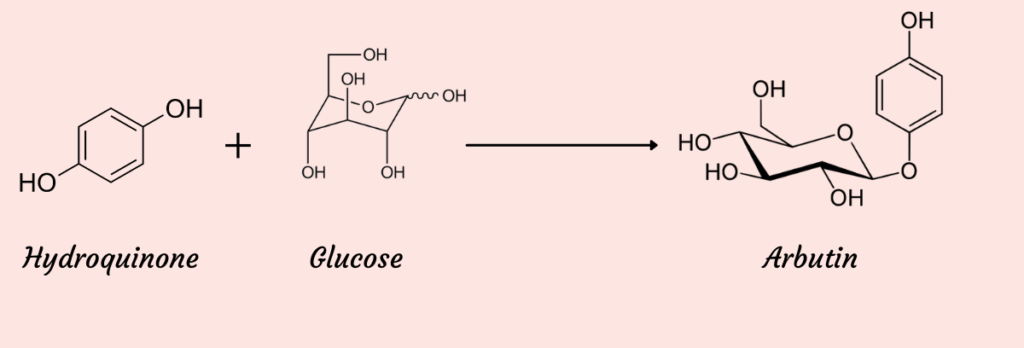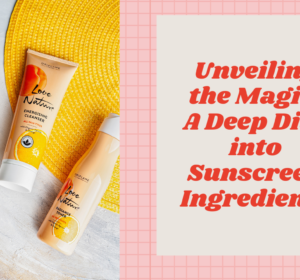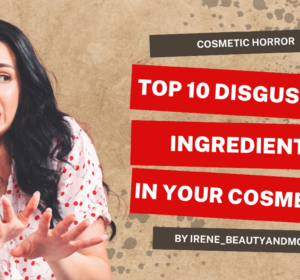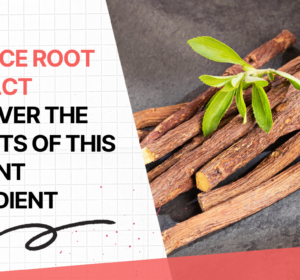‘Dark spots’ is something very common nowadays. Dark spots can be the result of different factors such as age, sun damage, hormonal changes and many other reasons. Arbutin is one of the most popular and effective ingredients to treat and reduce dark spots. In this post, I am going to discuss different aspects of arbutin in cosmetics.
What is arbutin?
Arbutin is a derivative of hydroquinone. Hydroquinone is the main molecule used to treat dark spots. It is a banned ingredient for cosmetics use and restricted for professional use in artificial nail systems to a concentration in the final product up to 0.02%. For topical application, it requires medical supervision and you can only buy it with a prescription.

Arbutin is glycosylated hydroquinone, which means that it is like hydroquinone but with an additional sugar molecule bonded to it. Arbutin is present naturally in different plants such as bearberry, wheat, pear skins, and some other foods. Bearberry is the plant traditionally used to extract arbutin. The arbutin found in these plants has the glucose bonded to the hydroquinone through a beta-bond.
Glucose has the ability to bind other molecules in two different ways – alpha and beta. They differ only in the special distribution. However, from a metabolic point of view, this difference is very important as some enzymes will be able to act only over one of the forms. As an example, think about starch and cellulose. There is an obvious difference between them, however, their chemical composition is exactly the same. The unique difference is that one has alpha bonds whereas the other has beta bonds. Nevertheless, we can digest only starch.
With arbutin, something similar happens. The natural arbutin is in beta disposition. Beta-arbutin has been used for ages and has some effects on the skin. Conversely, alpha-arbutin is relatively new. It is the form prepared in the laboratories and it shows higher performance.

Properties of the arbutin in cosmetics
Arbutin has different benefits in cosmetics. The most important are:
- Reduces the effect of sun exposure
Arbutin helps to reduce the darkness in the skin after sun exposure. However, that does not mean that you should not wear a sun protector.
- Reduces dark spots.
Arbutin is highly efficient in dark spot reduction because it has two different modes of action which I will mention in brief.
- Helps to reduce scars.
It is also very effective in reducing the scars produced by acne.
- Helps to brighten the skin.
The skin looks luminous with an even tone as a consequence of the dark spots and scars reduction.
- You can use arbutin in combination with other ingredients
Arbutin does not reduce the effect of other molecules and it is frequent to use it in combination with other ingredients such as niacinamide, azelaic acid, kojic acid, among others.
- It is more gentle with the skin than hydroquinone.
Hydroquinone reduces dark spots very efficiently as it destroys the cells responsible for producing melanin. That makes hydroquinone quite aggressive and not suitable for people with sensitive skin. The mode of action of arbutin is different, so much more gentle, and normally does not produce undesired reactions.

How does arbutin works in cosmetics?
As mentioned before, arbutin has two different modes of action. In the first place, arbutin is a tyrosinase inhibitor reducing, therefore, melanin production. As I explained in the post about hyperpigmentation, melanin production starts with the oxidation of the tyrosine in DOPA by the action of tyrosinase. Arbutin inhibits the enzyme tyrosinase and hence the melanin production from the first steps of its production.
Arbutin is structurally similar to the substrate which binds tyrosinase. There is, therefore, a competition between tyrosinase’s substrate and arbutin for the enzyme’s active site.
Together with this tyrosinase inhibition arbutin inhibits another enzyme, the DHICA polymerase (5,6-dihydroxy-indole-2-carboxylic acid). As a result, there is an inhibition in the transformation of DOPA in DOPA-quinone.
Finally, arbutin has another mode of action which consists in accelerating melanin decomposition and elimination.

How to use arbutin in cosmetics?
There are different options of cosmetics containing arbutin. Arbutin is available as a cream, serum, lotion, etc. Normally, these cosmetics have an arbutin concentration in the range of 1 to 5%. Keep in mind that arbutin may appear in the ingredient list under different names. The most used names are Arbutin and alpha-arbutin but sometimes appears as bearberry extract, uva-ursi extract, or hydroquinone derivative.
Arbutin is a gentle ingredient and as such, it can be used twice a day for most people. It is normally well-tolerated even for people with sensitive skin. However, it is convenient to use sunscreen after using arbutin.
Sometimes the arbutin is used in combination with other ingredients. It is very common to find it in combination with hyaluronic acid. Personally, I love to combine arbutin with niacinamide and kojic acid, all of them with anti-pigmentation properties.
Sides Effects of Arbutin
Though arbutin is a safe ingredient, there are some side effects that may appear associated with the use of this molecule. They are not common, but you should stop using arbutin if one or more of the following symptoms appear:
- Itchy skin
- Burning feeling
- Redness
- Peeling
Benefits of arbutin in cosmetics
As a summary, the main benefits of arbutin are:
- A great remedy for diminishing scars
- Its active component is released slowly
- Prevent hyperpigmentation
- Has sun protection properties
- Gentle on skin
- Improves uneven complexions
- Can be used twice a day
- Safer than hydroquinone
- Brightens skin
| Scientific Name | 4-Hydroxyphenyl-alpha-D-glucopyranoside |
| INCI Name | Alpha – Arbutin |
| Molecular Formula | C12H16O7 |
| Soluble in | Water |
| Type of Ingredient | Antioxidant, Bleaching |
| Main benefits | Lighten dark spots Reduces the appearance of scars Evens skin tone |
| Indicated for | All skin type |
| How often can you use it | Twice a day |
| Works well with | Vitamin C, Niacinamide, AHA |
Do you use arbutin in your skincare routine? What do you think about it? Let me know in the comments.


Bear in mind that some of the links in this post are affiliate links and if you go through them to make a purchase I will earn a commission. Keep in mind that I link these companies and their products because of their quality and not because of the commission I receive from your purchases. The decision is yours, and whether or not you decide to buy something is completely up to you.



